It looks like you're using an Ad Blocker.
Please white-list or disable AboveTopSecret.com in your ad-blocking tool.
Thank you.
Some features of ATS will be disabled while you continue to use an ad-blocker.
10
share:
Between massive swarms and habitat invasions, jellyfish are changing ecosystems, stinging beachgoers, and causing millions of dollars’ worth of damage. Using high-tech underwater gadgets, scientists are racing to understand one of the most common, mysterious and destructive sea creatures
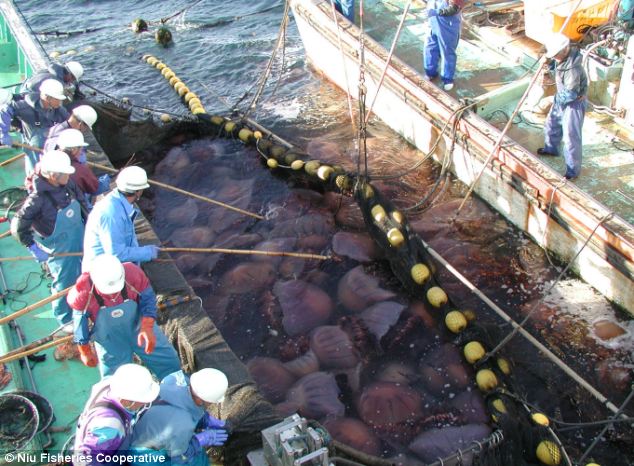
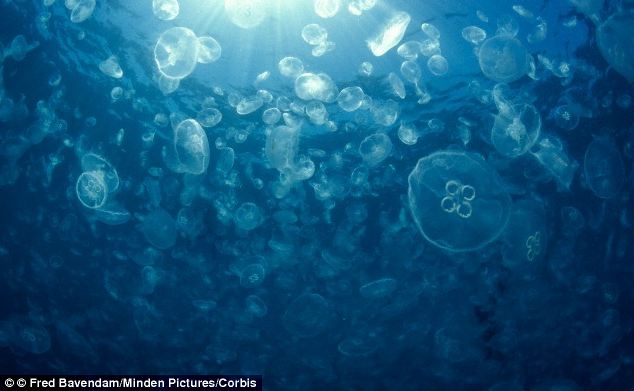
They are made of 95 per cent water and have no brain, but some experts fear a jellyfish invasion could be on the way.
Last week, a wave of jellyfish forced one of the world’s largest nuclear reactors to shut down - a phenomenon that marine biologists believe could become more common.
Experts are now claiming the creatures could be more dangerous than first thought, wreaking havoc in our oceans, posing a threat to human life and blocking up large coastal structures.
And they now believe it may now be too late to stop them.
A study by University of British Columbia in Canada last year found increasing jellyfish populations in 62 per cent of the areas they looked at, including East Asia, the Black Sea, Hawaii and Antarctica
Hei! jellyfish forced one of the world’s largest nuclear reactors to shut down!
and other bad thing..!
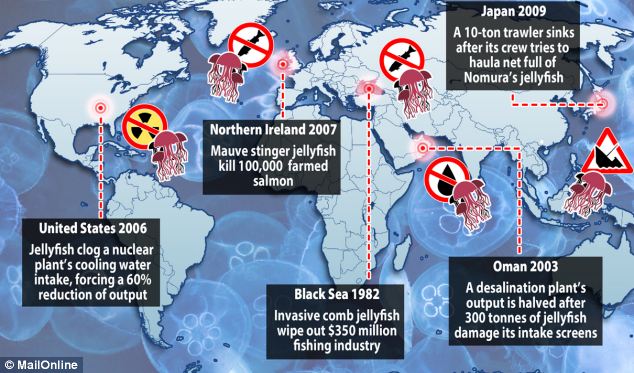
Yeah This is What i say Wrath Of the Nature..
There is 2 Kind Of This Monster that make me wonder if they covering all the sea :
1.
Mnemiopsis, is able to lay eggs when it is just 13 days old without needing a mate. It soon is able to lay 10,000 eggs per day. It also can eat over ten times its own body weight in food and can double in size each day.
2.
the zombie jelly, is seemingly immortal. When its particles disintegrate, cells escape and form an entirely new jelly. This period of growth happens within five day.
www.dailymail.co.uk...^h eadlines
and remember spongebob scane that Jellyfish on rockbottom?
this is one of many case :
JellyFish Invation Northern Ireland's farmed-salmon population..

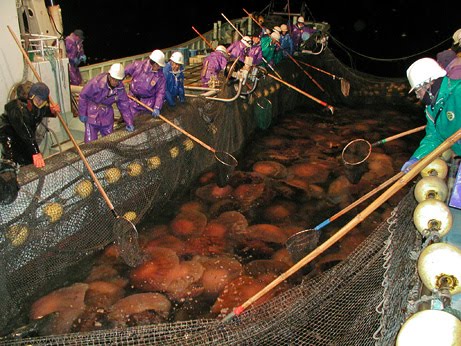
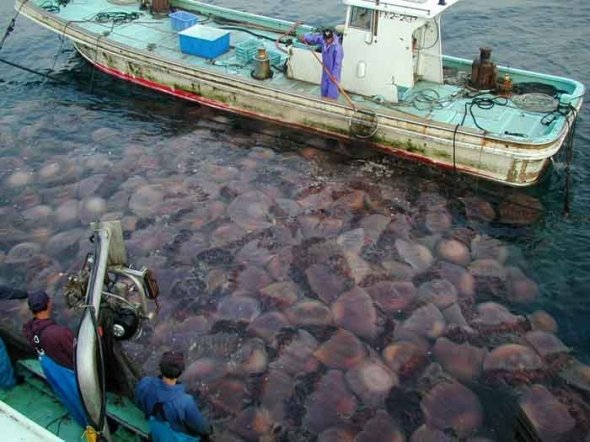
Last November, a 10-mile-wide and 42-foot-thick swarm of baby mauve stingers (Pelagia noctiluca) decimated Northern Ireland's farmed-salmon population. Overnight,120,000 fish were reduced to a floating mass of carcasses by billions of the small jellies native to warmer waters thousands of miles to the south. The salmon, which were killed by stings and oxygen deprivation, had a market value of $2 million.
Since 1996, massive "blooms" of mauve stingers have also plagued Mediterranean beachgoers. In previous decades, the jellies showed up along the French Riviera every 10 to 12 years and remained for about four years before retreating. But that pattern changed in the 1990s as the time span between the infestations shortened and jelly numbers shot up. In 1996, the Mediterranean coast experienced its largest blooms ever. The jellies retreated in 1998 but returned in even greater numbers just five years later. In August 2006, 60 million jellyfish reportedly swept up on Spanish beaches and stung more than 70,000 people, causing swollen limbs and allergic reactions. Beaches were closed throughout the entire region.
www.popsci.com...
So who was wrong? Human that Poluted Sea so this Monster empire rise..orrr the revenge of Brainless Nature Power make damage to human Bussines and Ecosystem?
We disrupted marine ecosystems by overfishing and acidification. The jelly fish are the result.
Might as well eat them if they're in abundance.. they're cheap!
Might as well eat them if they're in abundance.. they're cheap!
webedoomed
We disrupted marine ecosystems by overfishing and acidification. The jelly fish are the result.
Might as well eat them if they're in abundance.. they're cheap!
Eat them sir? are you sure?
haha
reply to post by cheesy
I already thought jellyfish were kinda creepy but this post plus the pictures added to it have freaked me right out. It is kind of fascinating such a creature could cause such massive amounts of damage and problems, but I just can't overcome the ick vibe. Good job putting this information together!
I already thought jellyfish were kinda creepy but this post plus the pictures added to it have freaked me right out. It is kind of fascinating such a creature could cause such massive amounts of damage and problems, but I just can't overcome the ick vibe. Good job putting this information together!
Breaded & deep fried...you wouldn't believe the stuff that becomes edible simply by breading it & frying it up
It shows that humans cannot destroy the environment, just change it.
Look at birds and insects that also adapt extremely well, flourish even, when humans overtake an area.
Whether this is good or bad is a personal choice but the fact cannot be denied that human involvement certainly benefits some species while destroying others.
Look at birds and insects that also adapt extremely well, flourish even, when humans overtake an area.
Whether this is good or bad is a personal choice but the fact cannot be denied that human involvement certainly benefits some species while destroying others.
Mother Earth is tired of the destruction it is facing, she will retaliate.
new topics
-
The Great Reckoning
Rant: 5 hours ago -
The Inconvenient Bellwether County Dilemma
Education and Media: 6 hours ago -
Elite Universities Are Coddling Students Grieving Over Trump's Victory
Mainstream News: 6 hours ago -
Witnesses who will testify in next week's hearing on UAPs
Aliens and UFOs: 6 hours ago -
Qatar kicks out HAMAS
Middle East Issues: 6 hours ago -
leftwing wymen shaving their head in protest
US Political Madness: 8 hours ago -
Racist Text Messages Mass Distributed
Social Issues and Civil Unrest: 9 hours ago -
No, the election results aren't reminiscent of 1930s Germany. But this is.
US Political Madness: 10 hours ago -
Agree or Disagree
2024 Elections: 11 hours ago
top topics
-
The Inconvenient Bellwether County Dilemma
Education and Media: 6 hours ago, 29 flags -
The Great Reckoning
Rant: 5 hours ago, 19 flags -
Leaving the US due to severe TDS?
US Political Madness: 13 hours ago, 14 flags -
No, the election results aren't reminiscent of 1930s Germany. But this is.
US Political Madness: 10 hours ago, 14 flags -
Elite Universities Are Coddling Students Grieving Over Trump's Victory
Mainstream News: 6 hours ago, 13 flags -
Qatar kicks out HAMAS
Middle East Issues: 6 hours ago, 13 flags -
leftwing wymen shaving their head in protest
US Political Madness: 8 hours ago, 11 flags -
Agree or Disagree
2024 Elections: 11 hours ago, 8 flags -
Witnesses who will testify in next week's hearing on UAPs
Aliens and UFOs: 6 hours ago, 6 flags -
Racist Text Messages Mass Distributed
Social Issues and Civil Unrest: 9 hours ago, 4 flags
active topics
-
leftwing wymen shaving their head in protest
US Political Madness • 73 • : theatreboy -
President-Elect DONALD TRUMP's 2nd-Term Administration Takes Shape.
Political Ideology • 61 • : Kaiju666 -
Agree or Disagree
2024 Elections • 19 • : fringeofthefringe -
Mood Music Part VI
Music • 3697 • : underpass61 -
Old School Punk
Music • 558 • : underpass61 -
Elite Universities Are Coddling Students Grieving Over Trump's Victory
Mainstream News • 17 • : baddmove -
Interesting timing 40 monkeys flee medical lab in US
Diseases and Pandemics • 18 • : Flyingclaydisk -
82 yr Woman Arrested for Hate Crime after Assaulting Trump Supporters
2024 Elections • 28 • : CriticalStinker -
Where ARE the 20 million votes??? Where ARE they????? WHERE???
US Political Madness • 53 • : navigator70 -
Racist Text Messages Mass Distributed
Social Issues and Civil Unrest • 19 • : MetalThunder
10
